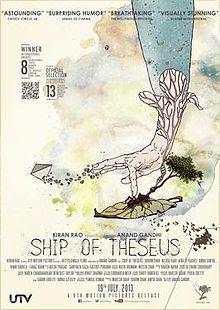
The ship wherein Theseus and the youth of Athens returned from Crete had 30 oars, and was preserved by the Athenians, for they took away the old planks as they decayed, putting in new and stronger timber in their places, in so much that this ship became a standing example among the philosophers, for the logical question of things that grow; one side holding that the ship remained the same, and the other contending that it was not the same.
-- Plutarch (Greek historian, 45-120 A.D.)Ship of Theseus is an unusual and a philosophical film from India. It deals with an interesting philosophical subject that Plato and Socrates debated, philosopher John Locke postulated replacing the ship with a torn sock, and Jules Verne used in his story Dr Ox’s Experiment.
It is unusual for several reasons.
First, much of the film Ship of Theseus is in English and, that too, in good spoken English, and represents visuals of mostly emerging urban India.
Second, it is not a big budget film (made with less than the equivalent of US$ 0.19 million as per IMDB, a fraction of what it takes to make a commercial Indian film in Bollywood) and yet has good technical quality--quality that earned it international awards. The sound design is credited to a talented Hungarian duo who did sound design of British director Peter Strickland’s Katalin Varga (2009) and two of the Hungarian director Bela Tarr’s films The Turin Horse (2011) and Werckmeister Harmonies (2000).
Third, one segment of the movie has as an actress Aida El-Kashef, an Egyptian filmmaker, who filmed the famous Tahrir Square protests in her country. Her performance in Ship of Theseus won her the Best Actress award at the Dubai International Film Festival, and the Best Supporting Actress Award at the 61st Indian National Film Awards.
Fourth, the film, which does not have any commercial trappings, was released briefly in major theatres in India and subsequently won the country’s top national award, the Golden Lotus, in 2014 for the best feature film of the year. The film also picked up awards for the Best Film at the Transylvania film festival. A dream achievement indeed for a debut filmmaker from India!
And finally, Ship of Theseus is a rare work of cinema that highlights ancient Jainism as a religion that sprouted in India and continues to be a way of life of millions, even to this day.
Plutarch’s conundrum is placed before the viewer by director Anand Gandhi, and his two co-scriptwriters Khusboo Ranka and Pankaj Kumar, by presenting three disconnected modern tales on human organ replacement to extend the concept of aging parts of the fabled ship of Theseus being replaced with new parts until all its original parts are replaced . Each of the three segments of the film Ship of Theseus approaches the effects of the physical replacement with different perspectives.

The blind photographer (Aida El-Kashef) capturing urban India
on camera aided by sounds
In the first segment, an almost blind photographer (Aida El-Kashef) clicks away with her camera, using intuition, touch and sounds to come up interesting photographs that are eventuially exhibited as art. On regaining her sight, the photographer reviews her blind work. The concept of “good creative“ art, once applauded, is reassessed by its creator, post her critical organ transplant.

Barefoot Jain monks meditating on the sea front captured against the backdrop
of a recently constructed bridge in Mumbai
In the second segment of the film, a well-educated, well-read Jain monk Maitreya (played by theater actor Neeraj Kabi) spearheads a legal war against the torture of animals for the benefits of medical research of the pharmaceutical industry. The very same medical world points out that Maitreya’s liver has cirrhosis and needs to be treated with drugs or even replaced. As with most Jain monks, for whom the concept of “Santhara” or fasting to death is an option, Maitreya has to choose between what his religion, which he has practised over decades promotes, and an option of modern medication combined with organ transplants. (The concept of “Santhara” has been in the news in recent days as an Indian court ruled it to be similar to abetment of suicide, provoking Jains to point out that it conflicted with their fundamental freedom guaranteed by the Indian Constitution.) The option before Maitreya is not a Hobson’s choice. However, Maitreya’s final decision in the film makes one rethink about all our own moral stands, not just his. What director Gandhi’s film asks is if a critical organ transplant can change the views of a well-read, ethical person as well.

Wrecked and junked cars are a metaphoric backdrop for a converstion on
the illegal human organ trade
The third segment of the film Ship of Theseus deals with the growing problem in India where the poor and the uneducated are robbed of their organs without their knowledge by a growing organ transplant villains who sell their spoils to unsuspecting rich clients worldwide who need the organ to survive. In this segment, Gandhi’s film questions the ethics and morality among the world of organ recipients, the organ robbers and the amazing evolutionary changes in the views of morality of those who were actually robbed of their critical organs. A young bright stockbroker Navin (Sohum Shah) stumbles on the larger story of unethical human organ transplants and tries to help a poor labourer, who was robbed of an organ unwittingly. But the outcome of his efforts is even more thought provoking.
Young Anand Gandhi brings all the three protagonists of his film Ship of Theseus together reprising what the famous Polish director Krzysztof Kieslowski had done at end of Three Colours Red (his final part of the trilogy, made in 1993-4) by bringing the critical characters of Three Colours Blue, Three Colours White and Three Colours Red briefly by a seeming cosmic coincidence. Kieslowski showed the characters as lucky survivors of a boat tragedy, but Gandhi shows his varied characters as lucky survivors of the organ transplant medical operations in India. In Kieslowski‘s three celebrated films, a key character always cried at the end. In young Gandhi’s film, no one sheds tears as the characters from the three segments watch a film together on caves and the exploration of the unknown, a visual metaphor of the film in itself.
Anand Gandhi and Aida El-Kashef have won accolades at international film festivals for their respective contributions to Ship of Theseus. Equally creditable is the contribution of cinematographer and co-scriptwriter Pankaj Kumar, whose talents are quite evident. Several handheld photographic sequences of the film such as the sequences involving extremely narrow and winding approaches to the labourer’s living quarters and the exterior shots of the peripatetic monks against modern windmills and electric pylons taken from another high vantage point, ask questions of the viewer the effect on the rapid changes in Indian society on past beliefs and social views that also relate to the same primary Ship of Theseus conundrum. Pankaj Kumar won awards for his contribution as a cinematographer for Ship of Theseus at the Transylvania film festival, the Tokyo International Film festival, and at the Mumbai International Film Festival. The talented Pankaj Kumar has subsequently moved on to commercial mainstream Bollywood cinema working on films such as Haider and Talwar. Ship of Theseus also brought to the limelight a fascinating stage actor Neeraj Kabi, who plays the Jain monk in the middle segment of the film. Kabi, according to reports lost 17 kg in weight, over 5 months, to enact the starving monk. Actors such as Kabi are rare to come by and he was spectacular in his role.
The movie Ship of Theseus not merely raised the quality of contemporary Indian cinema but proved that good cinema can be made with low budgets, if truly talented people made the film. Most importantly, it is a rare film made in India that forces the viewer to think about philosophy rather than provide escapist entertainment. Such films do not just win international awards but provide quality entertainment for the discerning viewer. Evidently, it was not considered as an Indian entry for the Oscars because the film is in English, which eliminated it from being considered in the foreign film category. Young Anand Gandhi needs to be congratulated for roping in the rich talent from diverse fields to make his remarkable debut film with a limited budget.
P.S. Indian cinema has seen some young filmmakers accomplishing interesting works with limited budgets in recent years. Sudevan’s CR. No. 89 (2013) is one such film made in Malayalam language reviewed earlier on this blog. Another is Praveen Morchale’s Barefoot to Goa (2015) in Hindi, also reviewed earlier on this blog.

